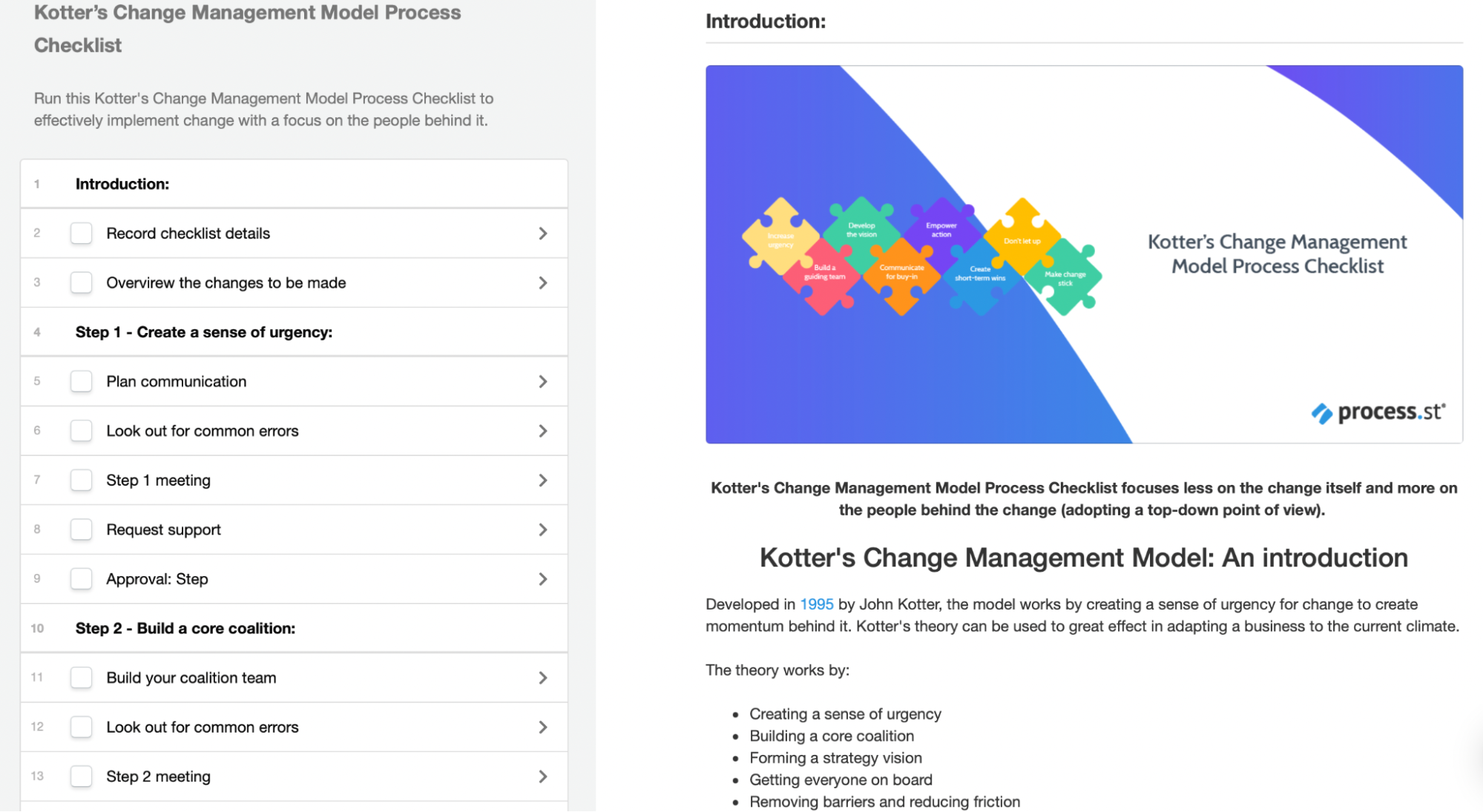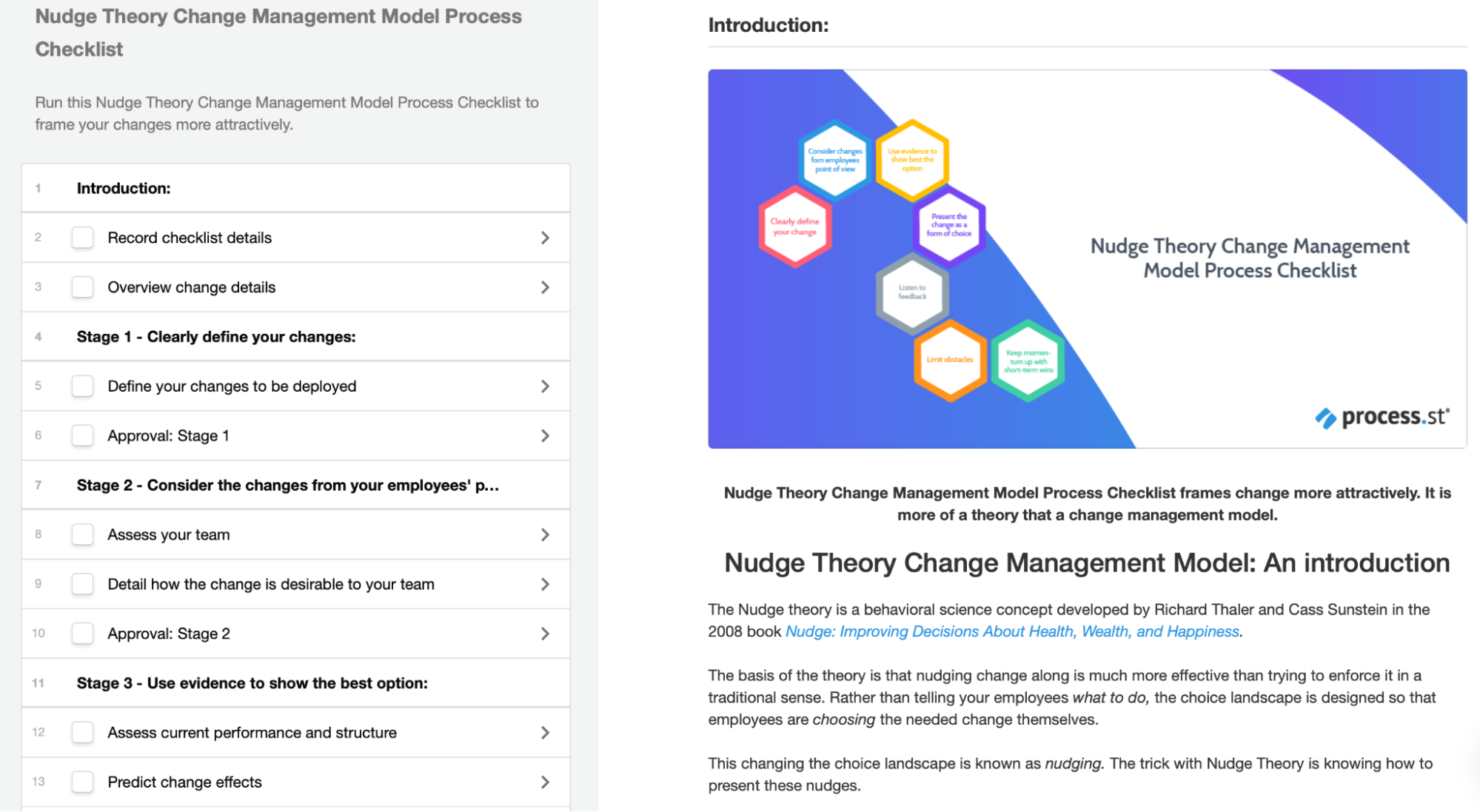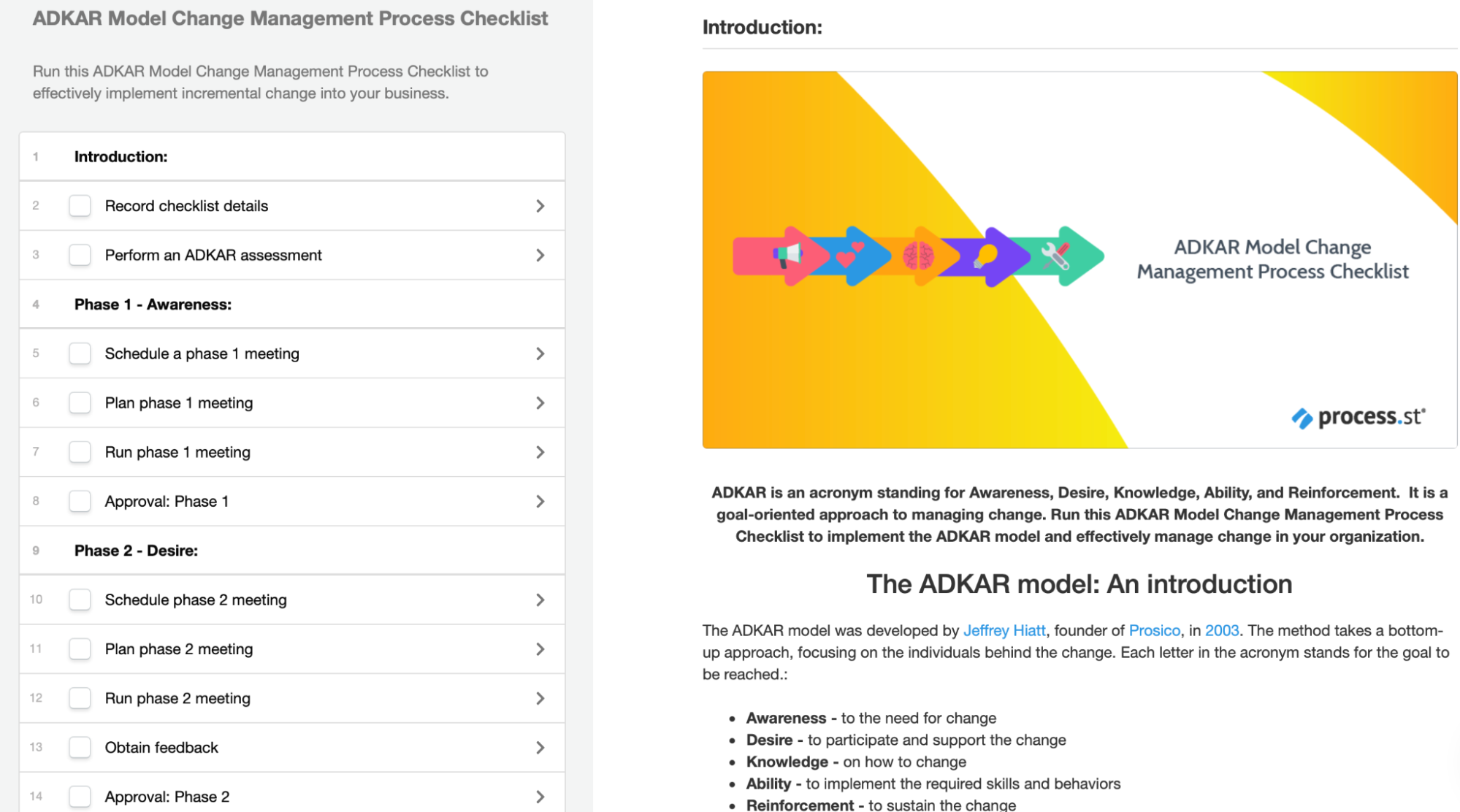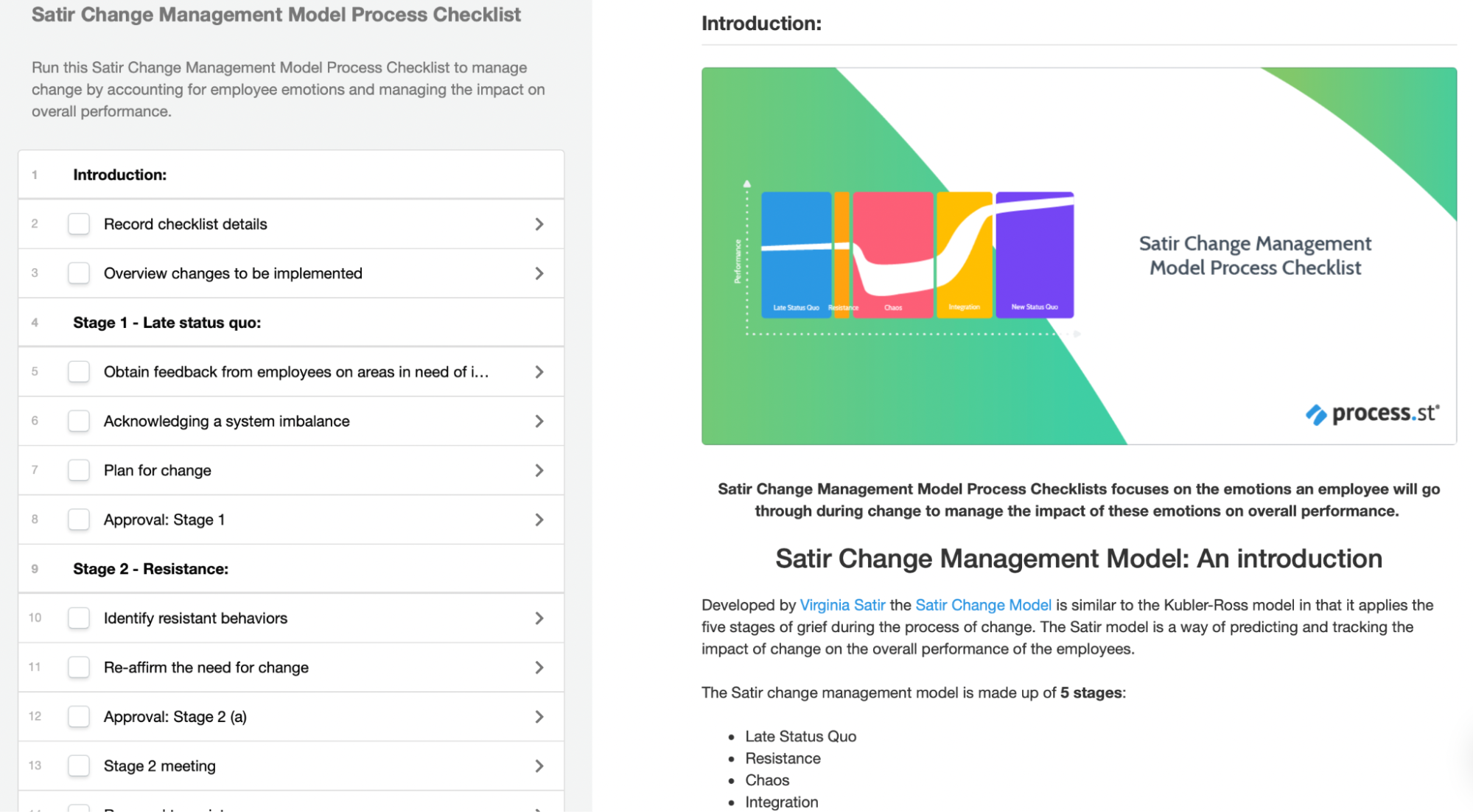 Constantly evolving with the times empowers you to see valuable growth take place in your company. At first you can oversee everything in the company yourself, keeping tabs to ensure things are up to date and running as intended. Then you grow, and suddenly you don’t have time to monitor those changes. For all you know everyone could be saying “yeah, I did that yesterday,” but be cutting corners left and right.
Constantly evolving with the times empowers you to see valuable growth take place in your company. At first you can oversee everything in the company yourself, keeping tabs to ensure things are up to date and running as intended. Then you grow, and suddenly you don’t have time to monitor those changes. For all you know everyone could be saying “yeah, I did that yesterday,” but be cutting corners left and right.
That’s where having a change management strategy will save you. Analyzing the changes you want to make and seeing how the rest of your company is affected prepares your teams in advance and helps guide them through this transition until these new changes become routine.
Whether you’re changing software, updating technology, hiring new staff, or starting a new project, you’re going to benefit from a solid change management strategy.
The areas of change management, like most things, can become increasingly more complex with the more time you spend doing it. If you want to master the way you take on change in your company, then this is the right Process Street article for you.
I’m going to take you through all things change management. This includes some tips for creating an effective change management strategy, possible methods you might want to implement, and how Process Street can help you along the way.
- What change management methods are we looking at?
- What is change management
- Don’t underestimate the importance of a change management strategy
- Tips for creating an effective change management strategy
- Become a change management master with Process Street
It’s time to reliably and effectively make those changes in your business – and watch it grow! Let’s get into it.
What change management methods are we looking at?
Change management models are super cool. Why? Really smart people have taken an in-depth look at change management and put together a model that they believe can work well in a company – so that you don’t have to.
Finding a model that you like is great because it already gives you a ‘skeleton’ of what you might want to be doing to implement change into your business.Even better – we’ve created checklists embodying these different models to make following them as easy as possible. Let’s take a look.
Lewin’s change management model
Each change management method follows the principles laid out above, but Lewin takes a deeper view on the need for change. His theory is that you need to “unfreeze” the entire way that things are done, make your changes, then “refreeze” to lock the new model into your company’s mindset.
Although Lewin’s method isn’t too useful for minor changes, if a serious overhaul to one of your systems or core pieces of technology is required then this is a fantastic way to dig up everything that could be affected.
Start using our Lewin’s change management model template now!
McKinsey’s 7-S model
McKinsey’s 7-S model highlights seven core areas which are interlinked and must be considered with every change: strategy, structure, systems, shared values, style, staff, and skills. Much like Lewin, this is a good model to use when you’re trying to cover every part of your company that your change affects, especially if you want to focus on your employees and how to get them to adopt it.
Kotter’s theory
Kotter takes a much more human-centric approach, with an 8-step method to inspire initial action by explaining the need for change, then guiding it through by keeping up that momentum.
In essence, you meet with the key figures affected by your change, create a sense of urgency by teaching them why it’s important and what the benefits are, then use short-term goals to keep up the enthusiasm for the change. After all, it’s easy to start a project, but unless you’re getting a steady drip feed of positive feedback it can be difficult to see it through to the end.
 Start using our Kotter’s theory change management model now!
Start using our Kotter’s theory change management model now!
Nudge theory
While the previous methods are highly structured, the so-called “nudge” theory takes a slower, more passive role in bringing about change to avoid alienating people with massive sudden shifts.
This is done by gently suggesting or coaxing employees to move in the right direction rather than directly instructing them what to do, with the idea that they will consider the eventual changes to be their own idea and have a greater drive to see them through.
While it’s a little vague and difficult to employ (and some would even say manipulative), the idea of letting your employees grow and have an active role in changing your business for the better is a great way to make them more loyal, as they can see their input being deployed directly.
 Start using our Nudge theory change management model now!
Start using our Nudge theory change management model now!
The ADKAR model
ADKAR pays more attention to the individual, with its five-element form-like structure serving best as a kind of questionnaire you can hand out to your team to gather feedback and assess how effective your changes were.
As you’d expect, this is a great way to gather feedback on your changes to alter how you do things in future (but not necessarily plan in advance).
There’s nothing stopping you from using the model to plan out your changes, but the vague nature of each step leaves it a little lacking compared to some other models, hence why it’s best used to gather feedback.
 Start using our ADKAR change management model now!
Start using our ADKAR change management model now!
Bridges’ transition model
Bridges’ transition model dives into your team’s emotional reactions and uses those to cement the results. By separating the reaction that most people feel when faced with change into three stages (Ending, Losing, and Letting Go, The Neutral Zone, and The New Beginning), Bridges’ gives you a solid foundation to guide your employees through the various emotions that will likely accompany the change in order to let you effectively deploy them.
Kubler-Ross’s change curve
Kubler-Ross’s change curve is also emotion-driven, but is inspired by the titular psychiatrist’s five stages of grief, and explains how to guide employees through times of upheaval. By identifying what stage of the process an employee is in, you can tailor a response to them to guide them through the rest of the process.
The model can also be used to roughly estimate the impact of a change on your employees and their productivity. The results won’t be 100% accurate, since everyone responds to changes differently, but you can at least try to manage your business around the potential impact so that you’re not taken off guard and unexpectedly set back.
The Satir change management model
Finally, Virginia Satir’s change process is less of a “how-to” and more of an example of what your progress might look like upon making a change. Her model shows the general effect of a change on your performance, the ensuing chaos, and the resulting transformation to eventually reach a new height of productivity. This one’s great for tracking your changes, but also for predicting how long your productivity will be lower as a result of the change.
 Start using our Satir change management model now!
Start using our Satir change management model now!
What is change management?
Change management is a way of making sure that any changes you make in your organization, team, or processes are applied and maintained effectively. Usually this involves a dedicated change management team who analyze events such as swapping major company software, updating a process, requesting a new project, and so on. This team then works with both the technical and human side of your company to ensure that the changes are understood, accepted, and enacted.
Having an effective change management strategy instead helps the human elements of your company adapt to the changes that affect them. It can even forge stronger bonds between you and your employees as that attention to their needs (and giving some extra feedback opportunities) will let them know that their voices are being heard, which is vital from a moral and job satisfaction standpoint.
Here’s one of our free change management templates for you to check out right now.
Don’t underestimate the importance of a change management strategy
To succeed, companies need to be constantly changing and improving, whether that’s by reviewing their processes, training employees further, expanding their network, updating their technology, taking on new projects, or by doing something else. A company that doesn’t change and evolve is at a standstill, and therefore constantly (if perhaps slowly) falling behind their competitors.
Even major corporations aren’t immune to the danger of stagnation – take Yahoo, for example. By failing to adapt to the rise of social media and mobile advertising, Yahoo slipped from a market cap of almost $120 billion back in 2000 to just under $40 billion in June 2016. They’re still a big company, but the lack of effective change severely crippled their outlook.
So, by both encouraging change and increasing employee adoption of those changes, companies can both adapt to the times and customer demands while accurately knowing how everything is handled.
Tips for creating the best change management strategy
No matter what method or model you’re using to support your changes, there are eight core principles which hold true throughout the entire process.
Define the change
Change management exists as a practice to help changes be consistently and successfully applied across an entire company. As you’d expect, this is incredibly hard to do (if not impossible) if you don’t have a set definition of the change you’re going to make.
It’s no good giving vague benefits or descriptions; you need to lay out exactly what the change will be, how it will be achieved, how it will be tracked or measured, and what success metrics it should affect. It’s a single description or document that anyone in your company should be able to read, understand, and take action on.
Pages is a great place to define this change. The change description document lives alongside your existing business processes and everyone in your company has access to it. Easy! Now, onto step two.
Keep it simple
If you don’t keep your changes simple, nobody will want to take action on them. You need to be able to describe them in language which anyone can understand, and immediately see the benefit of.
If you can’t easily describe it, then you might be trying to do too much at once. Take a step back and break up your change into smaller chunks which can be enacted over time. That way you don’t risk alienating your employees or team members by ripping up their entire routine (although this can be necessary in dire situations).
Start at the top…
Before you try to convince your front line employees of the changes you want to make, it’s important to have your upper staff presenting a unified front. If you don’t make sure that everyone agrees on the changes and how they should be done, you could end up with each team taking a drastically different approach, leaving your success to random chance.
Worse still, if your teams aren’t unified in how they’re making changes, tracking any progress you make will become next to impossible, as there won’t be any common factors to track.
As such, you need to start your change management strategy with your managers. Make sure that they see eye-to-eye on what changes need to be made, how they should be done, what their ultimate goals should be, and so on (ideally by meeting with them all at the same time).
… But don’t forget the front lines
Upper management and team leaders might be able to coordinate the changes at a smaller level, but without listening to those on the front line you’re leaving massive room for error and dissent. So, once you’ve gotten your team leaders on board, you need to do the same for every employee.
Depending on the size of your company it might not be possible to meet with every employee one-on-one or even in small groups. Even if you could, they might be unwilling to voice their concerns and/or questions face-to-face.
Use culture to your advantage
A large part of managing change when it comes to the human elements of your company is knowing what your company culture is, along with its strengths and weaknesses. If you know how everyone works, communicates, what they like and dislike, what they do well, and what they don’t, you can plan out the best way to apply the changes you make, be it using new software or changing a process.
The ultimate change management strategy is to make sure everything runs smoothly rather than alienating your workforce with massive shifts in your practices. If you don’t know how they currently work and communicate, what you think is a minor alteration could become a massive rift, leaving the team to feel like they’re being ignored as people.
Tie changes to strategic and emotional benefits
The term “employee engagement” gets thrown around by many (including myself), but when managing change in your company you truly need to engage them on a logical and emotional level. It’s not enough to tell someone “this will help you work quicker” or “this program will make your job easier in the long run” – you need to link your changes to benefits that they will be personally motivated to achieve.
A couple of quick examples are:
- Having more time to spend on interesting tasks they enjoy doing
- Completing projects in advance to avoid late-night edits
- Branching out into more varied duties
These aren’t just employees after all – they’re people with differing interests, goals, and desires, and by linking the changes to benefits which appeal to them as people you can naturally encourage them to stick to the new way of doing things.
Encourage behavior shifts, not just actions
Telling an employee to perform an action will get the task done, but it won’t stop them from returning to their previous routine as soon as the project’s initial enthusiasm wears off. Telling them how to perform the new action will alter their behavior, and after a few repetitions, suddenly the change has become their new routine.
This comes back to considering the people in your company rather than just the technical aspects – saying how to approach a given task along with its new goals and thought process is a much more effective way of making sure that your changes stick.
Plus, if you can inspire a particular attitude among your team you can encourage them to more closely stick to their goals and produce high-quality work. You turn a team of people just doing what they’re told to a group with a central purpose, who aren’t afraid to take action to further that goal above and beyond their usual duties.
Support your changes with a formal framework
Without a set framework to follow you don’t stand a chance of being able to consistently deploy and track any changes made in your organization.Documented processes benefit businesses of literally any size (and even personal tasks) by giving a repeatable set of instructions which provide a set standard of quality.
Whether you’re looking at an editing checklist or a company-wide template for deploying changes effectively, you need to have a set framework to follow if you want to have any kind of consistency. Beyond that, you can only track and measure your success if you’re consistent, and you can only reliably improve if you can track your success.
Become a change management master with Process Street
Change management may sound intimidating, but as you’ve seen above, the majority of it is just taking a logical approach to the changes you make in your company and planning out what you’ll need to do as a result.
Uncertainty, confusion, and varied approaches are limited in return for a unified workforce which knows where it’s going, how it’s getting there, and how it needs to change to adapt.
Process Street can help ensure you get this unified workforce. After all, most changes are implemented through business processes. Process Street is the home of all your process documentation and workflows.
Any changes you want to make in your business processes can easily be implemented into your workflows with immediate effect – even workflows that are currently being used. It’s continuous improvement at its finest.
What are the biggest changes you’ve undergone professionally? Have massive internal changes thrown you off kilter, with no chance for feedback? Let me know in the comments below.







Ben Mulholland
Ben Mulholland is an Editor at Process Street, and winds down with a casual article or two on Mulholland Writing. Find him on Twitter here.